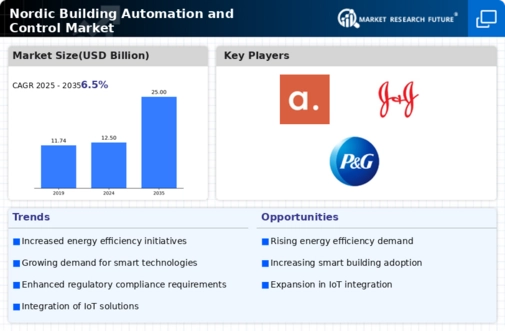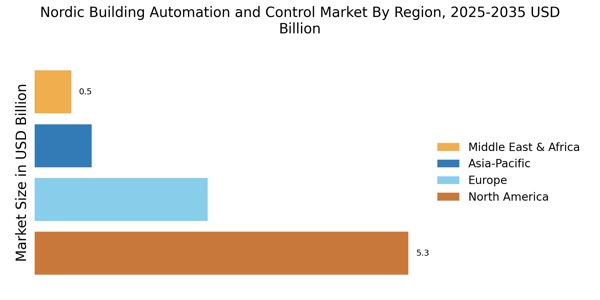Advancements in Data Analytics
The Nordic Building Automation and Control Market is increasingly leveraging advancements in data analytics to enhance building performance. The integration of big data and analytics tools allows for the collection and analysis of vast amounts of data generated by building systems. This capability enables facility managers to identify inefficiencies, predict maintenance needs, and optimize energy usage. As analytics technology continues to evolve, it is likely to play a pivotal role in shaping the future of building automation. The ability to harness data effectively can lead to improved decision-making processes and enhanced operational efficiency, positioning the Nordic market as a leader in innovative building solutions.
Integration of Smart Technologies
The Nordic Building Automation and Control Market is experiencing a notable shift towards the integration of smart technologies. This trend is driven by the increasing demand for interconnected systems that enhance operational efficiency and user comfort. Smart technologies, such as advanced sensors and automated controls, facilitate real-time monitoring and management of building systems. As a result, energy consumption can be optimized, leading to reduced operational costs. The market is projected to grow significantly, with estimates suggesting a compound annual growth rate of over 10% in the coming years. This growth is indicative of a broader movement towards smart buildings, where automation plays a crucial role in sustainability and energy management.
Regulatory Support for Sustainability
The Nordic Building Automation and Control Market benefits from robust regulatory frameworks that promote sustainability and energy efficiency. Governments in the Nordic region have implemented stringent building codes and standards aimed at reducing carbon emissions and enhancing energy performance. These regulations encourage the adoption of building automation systems that monitor and control energy usage effectively. For instance, the European Union's directives on energy performance have spurred investments in smart building technologies. As a result, the market is likely to see an influx of innovative solutions that align with these regulatory requirements, fostering a culture of sustainability within the construction and real estate sectors.
Growing Demand for Energy Management Solutions
The Nordic Building Automation and Control Market is witnessing a surge in demand for energy management solutions. This trend is largely attributed to the increasing awareness of energy conservation and the rising costs associated with energy consumption. Building owners and operators are seeking advanced automation systems that provide insights into energy usage patterns, enabling them to make informed decisions regarding energy efficiency. The market for energy management systems is expected to expand, with projections indicating a growth rate of approximately 12% annually. This demand is further fueled by the need for compliance with energy regulations and the desire to reduce operational costs, making energy management a critical focus area for the industry.
Rising Consumer Expectations for Comfort and Convenience
The Nordic Building Automation and Control Market is responding to rising consumer expectations for enhanced comfort and convenience in building environments. As occupants become more discerning, there is a growing demand for automation systems that provide seamless control over lighting, temperature, and security. This shift is prompting manufacturers to develop user-friendly interfaces and customizable solutions that cater to individual preferences. The market is likely to see an increase in the adoption of smart home technologies, which integrate with building automation systems to create a more personalized experience. This trend not only enhances occupant satisfaction but also drives the overall growth of the building automation sector in the Nordic region.

















Leave a Comment